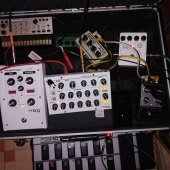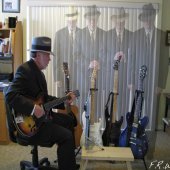-
Posts
1,338 -
Joined
-
Last visited
-
Days Won
2
Amberwolf last won the day on May 25
Amberwolf had the most liked content!
Reputation
641 ExcellentRecent Profile Visitors
8,550 profile views
-
In my experience, it's probqably not the file name length, but the many files involved (often tiny, but not always). If you have USB3, it's pretty danged fast as long as the port, drive/enclosure, and cables and any hubs in between support it. The biggest slowdown I've found so far is when the SSD / etc "write cache" (of whatever implementation) is filled by the transfer so the whole process is then slowed down as it has to first write all that to the flash locations it stays in, then clear that cache before it can accept any more data. That's a slow process for some drives, and some drives have very fast but small caches, whcih work great for typical usages, but not so great for huge data transfers and sometimes not for our type of usages with mutliple big file writes. The Samsung Evo SSDs I have are terrible at these things, but the Crucial SSDs are much faster. Both are in the same model and revision of the Sabrent USB-SATA cases, and have been tested on the same ports on the laptop, and the same hubs when that's needed. But they're all faster than the internal spinny drives I've got.
-
Guess it depends on why the problem exists within a specific person, and what the specific reactions that person has to the problem. If it's something that causes anaphylaxis, it's probably not a good idea to try that method.
-

Using AI for composition - Can i use the song ?
Amberwolf replied to giant ll's topic in General Music Discussion
Those are all questions you'd have to pay a lawyer to answer with even a remote bit of certainty...and the reality is that until it is tested in court, you still won't know the answer. Every person you ask is likely to have a variant opinion. Since none of them is likely to be the one dealing with your specific legal situation for you when something happens, what they say doesn't really matter. You can ask the companies whose services you will use to see what they say, but unless they are providing you with legal certainties in documented form, and you have a lawyer to interpret them all for you, those are probably not the final answer either. -
Amberwolf started following Sonar freezes for ~1.5 seconds every time I stop playback , Vegas Pro lifetime? , Dumb move of the day and 2 others
-
If you're up for just the previous version, 22, it's in a humble bundle for the next couple weeks. Lots cheaper than the manufacturer site.
-
note that many if not most ssd type storage is only fast for a tiny amount of data at a time. after the "cache" (different terms, same idea) is full then everything slows way down. nearly none are as fast as they claim to be for any kind of sustained write operation.
-

Using AI for composition - Can i use the song ?
Amberwolf replied to giant ll's topic in General Music Discussion
You mention "IA" several times, but you don't tell us what it is. Perhaps if you did, we might be able to help answer the question. A websearch found a few things like Internal Affairs, Iowa, In Absentia, etc, but I can't figure out how any of those are related to what you're asking about. -

AI and the future state of music creation
Amberwolf replied to Mr. Torture's topic in The Coffee House
That's in the linked thread. -

AI and the future state of music creation
Amberwolf replied to Mr. Torture's topic in The Coffee House
While it isn't really the same as what's being talked about here, but it is in the same vein in that it's about making a tool for an artist to create the thing they ahve a specific vision for, I am trying to create this tool for visual art here https://endless-sphere.com/sphere/threads/adrs-artist-directed-reality-synthesis-a-tool-to-help-artists-create.129368/ If there are any interested coders / scripters / artists, I would appreciate any input there that you can provide. -
You wouldn't have needed them if you didn't have to brake so hard after the speedbumpjump landings.
-
The hard part about that is the landing past the part of the road that curved away while you were still in the air.
-
I love that idea, but.... They';ll never do that here. It costs money to build and maintain and it doesn't cause enough problems for those not doing the thing they're there to prevent. It's much easier to dump a few pounds of asphalt or concrete in an inappropriate place with plenty of warnings to let speeders slow down just before they hit it but speed back up right afterward. There are various places around here where speeding in neighborhoods is a real problem, but instead of emphasizing the speed limits and the problems they can cause, with all the signage leading up to the speed bump, there are just signs warning that there is a speed bump ahead, usually several. There may nto even *be* a speed limit sign anywhere around, or a warning of why (like "caution: kids playing" or whatever).
-
A bump, for those that have these softwares (esp vegas)....
-

Sonar freezes for ~1.5 seconds every time I stop playback
Amberwolf replied to moonbooter's topic in Cakewalk Sonar
So, what are the specific differences between your programs that work and those that don't? I haven't seen any sign here that you have explored that, but it is your best bet to find out what the issue is and fix it. -
Apparently you can ask BOS for it directly here: https://discord.com/channels/943190629826068500/1251269239768219649/1447233893320097822 But so far, you're not really missing anything special.
-

Sonar freezes for ~1.5 seconds every time I stop playback
Amberwolf replied to moonbooter's topic in Cakewalk Sonar
Then I would check to see what specific differences there are between the settings in each of those vs Sonar, regarding Audio and MIDI. Make a "chart" that lists all of the settings in each one relevant to those, anything that is in the "panel" or "tab" for those in each program, and then compare them to see what's different in the ones that work vs the one(s) that don't.









